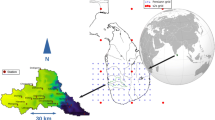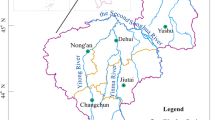Abstract
A hybrid statistical downscaling method based on the classification of rainfall patterns is presented which is capable of overcoming the poor representation of extreme events. The large-scale datasets, which are obtained from the National Centers for Environmental Prediction/National Center for Atmospheric Research (NCEP/NCAR) reanalysis data and the global circulation models (GCMs) outputs, and the local daily rainfall data are analyzed to assess the impacts of climate change on rainfall. The proposed method is composed of two steps. The first step is the classification of daily rainfall patterns. The detrended fluctuation analysis (DFA) is introduced to define the extreme rainfall. Two classification models, extreme rainfall and wet rainfall, are developed to describe the relationship between large-scale weather factors and rainfall patterns using support vector machine (SVM). These two models are able to identify the three rainfall patterns (the extreme, the normal and the dry rainfall) of the daily weather factors. The second step is the estimation of daily rainfall. The improved self-organizing linear output map (ISOLO) is adopted to estimate the rainfall for the aforementioned three different rainfall patterns. The future rainfall changes are calculated for the periods 2046–2065 and 2081–2100 under the A2 and B1 scenarios. An application to Taiwan has shown that the proposed method provides reliable and accurate rainfall-pattern classification. In addition, the improvement of the estimation of daily rainfall is significant, especially for the extreme rainfall. In conclusion, the proposed method is effective to overcome the poor representation of extreme events and the impacts of climate change on rainfall are analyzed.









Similar content being viewed by others
References
Alvarez-Ramirez J, Alvarez J, Rodriguez E (2008) Short-term predictability of crude oil markets: a detrended fluctuation analysis approach. Energy Econ 30:2645–2656
Bate A, Lindquist M, Edwards IR, Olsson S, Orre R, Lansner A, De Freitas RM (1998) A Bayesian neural network method for adverse drug reaction signal generation. Eur J Clin Pharmacol 54:315–321
Briining H, Trenkler G (1978) Nichtparametrische statistische Methoden. Walter de Gruyter, Berlin
Burger G, Murdock TQ, Werner AT, Sobie SR, Cannon AJ (2012) Downscaling extremes-an intercomparison of multiple statistical methods for present climate. J Clim 25:4366–4388
Caron LP, Jones CG (2008) Analysing present, past and future tropical cyclone activity as inferred from an ensemble of coupled global climate models. Tellus 60(1):80–96
Chang CC (2009) Improved self-organizing linear output map for reservoir inflow forecasting. Unpublished master’s thesis, National Taiwan University, Taiwan
Chau KW, Wu CL (2010) A hybrid model coupled with singular Spectrum analysis for daily rainfall prediction. J Hydroinf 12(4):458–473
Chen XY, Chau KW, Busari AO (2015) A comparative study of population-based optimization algorithms for downstream river flow forecasting by a hybrid neural network model. Eng Appl Artif Intell 46(A):258–268
Cover T, Hart P (1967) Nearest neighbor pattern classification. In IEEE Transactions in Information Theory, IT-13:21–27
Cristianini N, Shaw-Taylor J (2000) An introduction to support vector machines and other kernel-based learning methods. Cambridge University Press, New York
Devak M, Dhanya CT, Gosain AK (2015) Gosain dynamic coupling of support vector machine and K-nearest neighbor for downscaling daily rainfall. J Hydrol 525:286–301
Fisher RA (1936) The use of multiple measurements in taxonomic problems. Ann Eugenics 7:179–188
Gholami V, Chau KW, Fadaee F, Torkaman J, Ghaffari A (2015) Data-driven input variable selection for rainfall-runoff modeling using binary-coded particle swarm optimization and extreme learning machines. J Hydrol 529(3):1617–1632
Ghosh S, Katkar S (2012) Modeling uncertainty resulting from multiple downscaling methods in assessing hydrological impacts of climate change. Water Resour Manag 26:3559–3579
Gibbons JD (1992) Nonparametric statistical inference, 3rd edn. Dekker, New York
Gong ZQ, Feng GL, Wan SQ (2006) Analysis of features of climate change of Huabei area and the global climate change based on heuristic segmentation algorithm. Acta Phys Sin 55(1):477–484
Grau-Carles P (2006) Bootstrap testing for detrended fluctuation analysis. Phys A 360:89–98
Gutmann ED, Rasmussen RM, Liu C, Ikeda K, Gochis DJ, Clark MP, Dudhia J, Thompson G (2012) A comparison of statistical and dynamical downscaling of winter precipitation over complex terrain. J Clim 25:262–281
Hou W, Zhang DQ, Zhou Y, Yang P (2011) Stochastially re-sorting detrended fluctuation analysis: a new method to define the threshold of extreme event. Acta Phys Sin 60(10):109202
Hsu K-L, Gupta HV, Gao X, Sorooshian S, Ima B (2002) Self organizing linear output map (SOLO): an artificial neural network suitable for hydrologic modeling and analysis. Water Resour Res 38(12):1302
Hu K, Ivanov PC, Chen Z, Carpena P, Stanley HE (2001) Effect of trends on detrended fluctuation analysis. Phys Rev E64:011114
King LM, Irwin S, Sarwar R, McLeod AI, Simonovic SP (2012) The effects of climate change on extreme precipitation events in the upper Thames River basin: a comparison of downscaling approaches. Can Water Resour J 37:253–274
Kozubowski TJ, Panorska AK, Qeadan F (2009) Testing exponentially versus Pareto distribution via likelihood ratio. Commun Stat Simul Comput 38(1):118–139
Kunstmann H, Schneider K, Forkel R, Knoche R (2004) Impact analysis of climate change for an alpine catchment using high resolution dynamic downscaling of ECHAM4 time slices. Hydrol Earth SystSci 8(6):1031–1045
Lee T, Jeong C (2014) Nonparametric statistical temporal downscaling of daily precipitation to hourly precipitation and implications for climate change scenarios. J Hydrol 510:182–196
Lin GF, Jhong BC (2015) A real-time forecasting model for the spatial distribution of typhoon rainfall. J Hydrol 521:302–313
Lin B, Wesseh PK Jr (2013) What causes price volatility and regime shifts in the natural gas market. Energy 55:553–563
Lin GF, Chen GR, Wu MC, Chou YC (2009) Effective forecasting of hourly typhoon rainfall using support vector machines, Water Resour Res, Vol. 45, Article Number W08440
Liu B, Chen J, Chen X, Lian Y, Wud L (2013) Uncertainty in determining extreme precipitation thresholds. J Hydrol 503:233–245
Lu Y, Qin XS (2014) A coupled K-nearest neighbour and Bayesian neural network model for daily rainfall downscaling. Int J Climatol 34:3221–3236
Ludwig O, Nunes U (2010) Novel maximum-margin training algorithms for supervised neural networks. IEEE Trans Neural Netw 21(6):972–984
MacQueen J (1967) Some methods for classification and analysis of multivariate observations. Proceedings of the Fifth Berkeley Symposium on Mathematical Statistics and Probability. University of California Press, Berkeley, pp. 281–297
McCuen RH (2002) Modeling hydrologic change: statistical methods. Lewis publishers, CRC Press
Mearns LO, Giorgi F, Whetton P, Pabon D, Hulme M, Lal M (2003) Guidelines for use of climate scenarios developed from regional climate model experiments. Available for download at the IPCC Data Distribution Centre, http://www.ipcc-data.org/guidelines/
Nourani V, Khanghah TR, Baghanam AH (2015) Application of entropy concept for input selection of wavelet-ANN based rainfall-runoff modeling. J Environ Informatics 26(1):52–70
Olsson J, Uvo CB, Jinno K (2001) Statistical atmospheric downscaling of short-term extreme rainfall by neural networks. Phys Chem Earth Part B: HydrolOceans Atmos 26:695–700
Palutikof JP, Goodess CM, Watkins SJ, Holt T (2002) Generating rainfall and temperature scenarios at multiple sites: examples from the Mediterranean. J Clim 15(24):3529–3548
Peng CK, Buldyrev SV, Simons M, Stanley HE, Goldberger AL (1994) Mosaic organization of DNA nucleotides. Phys Rev E 49:1685–1689
Rashid M, Beecha S, Chowdhury R (2013) Simulation of extreme rainfall from CMIP5 in the Onkaparinga catchment using a generalized linear model. In: Piantadosi J, Anderssen RS, Boland J (Eds), MODSIM2013, 20th International Congress on Modelling and Simulation Modelling and Simulation Society of Australia and New Zealand, pp 2520–2526
Sushama L, Ben Said S, Khaliq MN, Nagesh Kumar D, Laprise R (2014) Dry spell characteristics over India based on IMD and APHRODITE datasets. Clim Dyn. doi:10.1007/s00382-014-2113-9
Taormina R, Chou KW (2015) Data-driven input variable selection for rainfall-runoff modeling using binary-coded particle swarm optimization and Extreme Learning Machines. J Hydrol 529(3):1617–1632
Teng J, Chiew FHS, Timbal B, Wang Y, Vaze J, Wang B (2012) Assessment of an analogue downscaling method for modelling climate change impacts on runoff. J Hydrol 472-473:111–125
Tseng HW, Yang TC, Kuo CM, Yu PS (2012) Application of multi-site weather generators for investigating wet and dry spell lengths under climate change: a case study in southern Taiwan. Water Resour Manag 26:4311–4326
Vapnik VN (1995) The nature of statistical learning theory. Springer, New York
Vapnik VN (1998) Statistical learning theory. John Wiley, New York
Wang WC, Chau KW, Xu DM, Chen XY (2015) Improving forecasting accuracy of annual runoff time series using ARIMA based on EEMD decomposition. Water Resour Manag 29(8):2655–2675
Willmott CJ, Rowe CM, Philpot WD (1985) Small-scale climate map: a sensitivity analysis of some common assumptions associated with the grid-point interpolation and contouring. Am Cartographer 12:5–16
Wu CL, Chau KW, Li YS (2009) Methods to improve neural network performance in daily flows prediction. J Hydrol 372(1–4):80–93
Yang TC, Yu PS, Wei CM, Chen ST (2011) Projection of climate change for daily precipitation: a case study in Shih-men reservoir catchment in Taiwan. Hydrol Process 25:1342–1354
Yoon J-H, Ruby Leung L, Correia J (2012) Comparison of dynamically and statistically downscaled seasonal climate forecasts for the cold season over the United States. J Geophys Res 117:D21109
Yu PS, Yang TC, Wu CK (2002) Impact of climate change on water resources in southern Taiwan. J Hydrol 260(1–4):161–175
Author information
Authors and Affiliations
Corresponding author
Rights and permissions
About this article
Cite this article
Lin, GF., Chang, MJ. & Wu, JT. A Hybrid Statistical Downscaling Method Based on the Classification of Rainfall Patterns. Water Resour Manage 31, 377–401 (2017). https://doi.org/10.1007/s11269-016-1532-2
Received:
Accepted:
Published:
Issue Date:
DOI: https://doi.org/10.1007/s11269-016-1532-2




